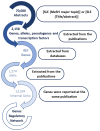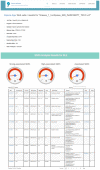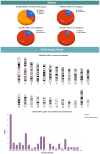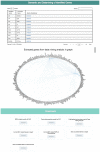Epione application: An integrated web‑toolkit of clinical genomics and personalized medicine in systemic lupus erythematosus
- PMID: 34791504
- PMCID: PMC8612305
- DOI: 10.3892/ijmm.2021.5063
Epione application: An integrated web‑toolkit of clinical genomics and personalized medicine in systemic lupus erythematosus
Abstract
Genome wide association studies (GWAS) have identified autoimmune disease‑associated loci, a number of which are involved in numerous disease‑associated pathways. However, much of the underlying genetic and pathophysiological mechanisms remain to be elucidated. Systemic lupus erythematosus (SLE) is a chronic, highly heterogeneous autoimmune disease, characterized by differences in autoantibody profile, serum cytokines and a multi‑system involvement. This study presents the Epione application, an integrated bioinformatics web‑toolkit, designed to assist medical experts and researchers in more accurately diagnosing SLE. The application aims to identify the most credible gene variants and single nucleotide polymorphisms (SNPs) associated with SLE susceptibility, by using patient's genomic data to aid the medical expert in SLE diagnosis. The application contains useful knowledge of >70,000 SLE‑related publications that have been analyzed, using data mining and semantic techniques, towards extracting the SLE‑related genes and the corresponding SNPs. Probable genes associated with the patient's genomic profile are visualized with several graphs, including chromosome ideograms, statistic bars and regulatory networks through data mining studies with relative publications, to obtain a representative number of the most credible candidate genes and biological pathways associated with the SLE. Furthermore, an evaluation study was performed on a patient diagnosed with SLE and is presented herein. Epione has also been expanded in family‑related candidate patients to evaluate its predictive power. All the recognized gene variants that were previously considered to be associated with SLE were accurately identified in the output profile of the patient, and by comparing the results, novel findings have emerged. The Epione application may assist and facilitate in early stage diagnosis by using the patients' genomic profile to compare against the list of the most predictable candidate gene variants related to SLE. Its diagnosis‑oriented output presents the user with a structured set of results on variant association, position in genome and links to specific bibliography and gene network associations. The overall aim of the present study was to provide a reliable tool for the most effective study of SLE. This novel and accessible webserver tool of SLE is available at http://geneticslab.aua.gr/epione/.
Keywords: bioinformatics; clinical informatics; data mining; genomics; systemic lupus erythematosus; variant analysis; whole exome sequencing; whole genome sequencing.
Conflict of interest statement
DAS is the Editor-in-Chief for the journal, but had no personal involvement in the reviewing process, or any influence in terms of adjudicating on the final decision, for this article. The other authors declare that they have no competing interests.
Figures









Similar articles
-
Demetra Application: An integrated genotype analysis web server for clinical genomics in endometriosis.Int J Mol Med. 2021 Jun;47(6):115. doi: 10.3892/ijmm.2021.4948. Epub 2021 Apr 28. Int J Mol Med. 2021. PMID: 33907838 Free PMC article.
-
Investigation of systemic lupus erythematosus (SLE) with integrating transcriptomics and genome wide association information.Gene. 2019 Jul 20;706:181-187. doi: 10.1016/j.gene.2019.05.004. Epub 2019 May 11. Gene. 2019. PMID: 31082500
-
Trait-stratified genome-wide association study identifies novel and diverse genetic associations with serologic and cytokine phenotypes in systemic lupus erythematosus.Arthritis Res Ther. 2010;12(4):R151. doi: 10.1186/ar3101. Epub 2010 Jul 26. Arthritis Res Ther. 2010. PMID: 20659327 Free PMC article.
-
The genetic basis of systemic lupus erythematosus: What are the risk factors and what have we learned.J Autoimmun. 2016 Nov;74:161-175. doi: 10.1016/j.jaut.2016.08.001. Epub 2016 Aug 10. J Autoimmun. 2016. PMID: 27522116 Review.
-
The genetics and molecular pathogenesis of systemic lupus erythematosus (SLE) in populations of different ancestry.Gene. 2018 Aug 20;668:59-72. doi: 10.1016/j.gene.2018.05.041. Epub 2018 May 25. Gene. 2018. PMID: 29775752 Review.
Cited by
-
Tracking genetic variants in the biomedical literature using LitVar 2.0.Nat Genet. 2023 Jun;55(6):901-903. doi: 10.1038/s41588-023-01414-x. Nat Genet. 2023. PMID: 37268776 Free PMC article. No abstract available.
-
Predictors Associated with Adverse Pregnancy Outcomes in a Cohort of Women with Systematic Lupus Erythematosus from Romania-An Observational Study (Stage 2).J Clin Med. 2022 Apr 1;11(7):1964. doi: 10.3390/jcm11071964. J Clin Med. 2022. PMID: 35407573 Free PMC article.
-
The Genetic Background of Ankylosing Spondylitis Reveals a Distinct Overlap with Autoimmune Diseases: A Systematic Review.J Clin Med. 2025 May 23;14(11):3677. doi: 10.3390/jcm14113677. J Clin Med. 2025. PMID: 40507438 Free PMC article. Review.
-
Semantic and Population Analysis of the Genetic Targets Related to COVID-19 and Its Association with Genes and Diseases.Adv Exp Med Biol. 2023;1423:59-78. doi: 10.1007/978-3-031-31978-5_6. Adv Exp Med Biol. 2023. PMID: 37525033
References
-
- Ramos PS, Criswell LA, Moser KL, Comeau ME, Williams AH, Pajewski NM, Chung SA, Graham RR, Zidovetzki R, Kelly JA, et al. International Consortium on the Genetics of Systemic Erythematosus: A comprehensive analysis of shared loci between systemic lupus erythematosus (SLE) and sixteen autoimmune diseases reveals limited genetic overlap. PLoS Genet. 2011;7:e1002406. doi: 10.1371/journal.pgen.1002406. - DOI - PMC - PubMed
MeSH terms
LinkOut - more resources
Full Text Sources
Medical

